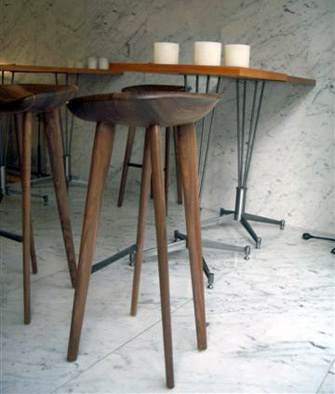 |
|
Architect Rem Koolhaas likes to play with planes and volumes Photo: C. Eaton |
Architect Colin Eaton offers a rebuttal to Richard Hesse’s description of the interior of the new Paris restaurant Le Dauphin, designed by Pritzker Prize-winning Dutch architect Rem Koolhaas and Clément Blanchet, as cold, noisy and cramped.
I agree with Richard Hesse’s comments – mostly. In relation to the food, absolutely. In relation to the noise levels, quite probably. In relation to the interior space, definitely not. What a space it is! Rem Koolhaas and his associate Clément Blanchet have created a celebration of white Cararra marble: the floor, walls and ceiling are lined with it.
To some it may seem cold and simplistic, but as an architect practicing in the area of restaurant design, I know firsthand how hard – how terribly hard – it is to achieve the “simple.” External factors outside the control of our architects’ wand – such as heating and ventilation, music systems, coffee machines and advertising signs, to name but a few – more often than not invade our purist aspirations and dilute that clear and simple initial concept.
Not at Le Dauphin! The purity has been carried through with rigor. I’ve eaten there twice, both times in the late evening, and Richard Hesse may be right about the marble being cold in the daytime, especially in the dull gray winter light, but at night – reflecting streetlights, car headlights and candlelight – it glows warmly.
An interesting detail created by the architect that may not be immediately evident to everyone’s notice is that the projecting pilasters or column surfaces on the side walls
 |
|
Sculptural wooden stools add to the pleasing effect of Rem Koolhaas’s interior. Photo: C. Eaton |
and the back wall are covered from top to bottom with mirrors, reflecting the activity on the street and adding visual depth to the space, belying its tiny size. The centrally placed, horseshoe-shaped bar, crafted from solid wood, and the sensuous, sculptural wooden stools add to the pleasing effect.
I always investigate the restroom to critique its design, and Le Dauphin’s is a celebration of white glazed tiles with gray grouting, all meticulously lined up. Great precision was exercised here in the way materials join, turn corners and line up.
I enjoy the way Rem Koolhaas plays with planes and volumes. His Casa da Musica in Porto, Portugal, plays on volumes in a similar way and enriches them with a variety of internal cladding materials. One space is entirely clad in glazed, patterned clay tiles and would make a great tapas bar itself.
I do wonder whether it is possible for Le Dauphin to maintain its architectural purity or whether various pollutants – signage, bar paraphernalia, coat stands, newspapers, the daily workings of a restaurant – will eventually dilute it and break the translation from architectural concept to physical reality.
During my first visit to Le Dauphin, I was also reminded of the American Bar in Vienna, designed in 1908 by Austrian architect Adolf Loos. There, too, a small space was imbued with rich detailing and surfaces, with cleverly placed mirrors reflecting the space. While incorporating a much more varied tapestry of materials, it still manages to accommodate the practical necessities of the bar’s daily workings a century later. Let’s hope Le Dauphin survives that long.
Le Dauphin: 131, avenue Parmentier, 75011 Paris. Métro: Goncourt. Tel.: 01 55 28 78 88. Nearest Vélib station: 140, avenue Parmentier. Open Tuesday-Friday for lunch and dinner, Saturday for dinner only. Fixed-price lunch menu: €27 (three courses). Tapas in the evening: €5-€12 per serving.
Reader Reaction: Click here to respond to this article (your response may be published on this page and is subject to editing).
© 2011 Paris Update
